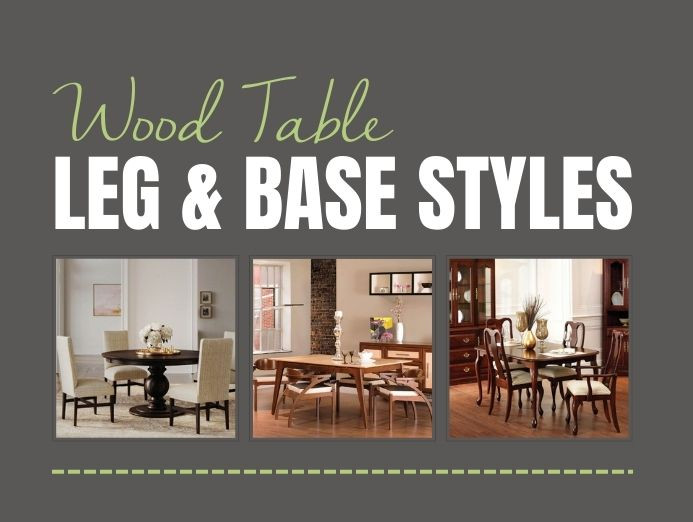How the Right Dining Room Table Legs Can Complete Your Dining Room Look
How the Right Dining Room Table Legs Can Complete Your Dining Room Look
Blog Article
From Standard to Modern: Discover the Ideal Dining-room Table Legs for Your Style
While traditional designs such as cabriole and transformed legs stimulate a sense of timeless refinement, contemporary styles like hairpin and geometric choices offer an opportunity for striking visual rate of interest. As you consider these components, the concern continues to be: how can you flawlessly integrate these diverse leg styles to create a harmonious dining experience?
Recognizing Table Leg Styles
The range of dining space table leg styles can substantially affect both the visual appeals and capability of the room. Each leg design adds special aesthetic aspects and useful attributes, dealing with varied style choices and usage demands. Recognizing these designs is vital for selecting the appropriate table that aligns with your total indoor design vision.
For instance, conical legs use a clean, timeless look that can improve a room's style, while stand bases supply stability and make best use of legroom, making them suitable for smaller sized spaces. Barrette legs, a trademark of mid-century modern-day design, present an industrial panache, permitting an airy, open feeling. Trestle legs stimulate rustic charm, giving durable assistance and a feeling of timelessness.
Wood legs can bring warmth and appearance, whereas steel alternatives frequently share a sleek, contemporary vibe. Eventually, recognizing table leg designs is crucial for developing a natural dining area that shows individual style while ensuring practicality and comfort.
Conventional Table Leg Options
When selecting dining-room table legs, traditional options frequently personify classic sophistication and craftsmanship. These designs reflect a rich heritage and a commitment to top quality, making them ideal for those who value timeless aesthetics.
Among the most iconic typical leg styles is the cabriole leg, defined by its stylish curved shape. This layout often includes ornamental makings and is most frequently discovered in Queen Anne and Chippendale furnishings. Another popular alternative is the transformed leg, which flaunts a collection of smooth, rounded shapes that supply a traditional look while maintaining stability.
Furthermore, the straight leg, while simple, offers a basic and tough structure that can blend seamlessly with a variety of tabletop styles. For those drawn to ornate outlining, claw-and-ball feet legs evoke a feeling of magnificence and can function as a sensational prime focus in any eating room.
Finally, stand bases, although not purely legs, offer an alternative traditional alternative that enables enough legroom and can be beautifully sculpted. Each of these typical leg styles adds to the general setting of an eating area, marrying function with aesthetic appeal.

Modern Table Leg Layouts
Modern table leg layouts use a varied range of styles that stress innovative products and tidy lines. These designs often prioritize capability while serving as striking centerpieces within an eating room. Minimalist aesthetics are widespread, with legs crafted from materials such as metal, glass, and crafted timber, which add to a modern and airy feeling.
One preferred design is the barrette leg, identified by its slender, conical framework that offers stability without overwhelming the table top (dining room table legs). This design is often discovered in mid-century contemporary furniture and can easily match various dining table shapes. An additional pattern is the usage of geometric shapes, where legs might tackle unbalanced or angular kinds, adding visual rate of interest and a touch of creativity

Mixing Styles for One-of-a-kind Spaces
Commonly, property owners seek to develop special dining spaces that mirror their individual style by blending numerous style elements. This approach permits for the consolidation of diverse visual appeals, causing an unified yet unique atmosphere. Coupling a rustic wooden table with smooth, contemporary steel legs can produce a distinctive contrast that boosts the space's general charm.
Additionally, incorporating vintage table legs with modern tabletops can stimulate a feeling of background while keeping a modern-day sensibility. Such combinations not just display private preference however also motivate imagination, permitting property owners to curate a space that really feels both personal and welcoming.
Shade plays an essential duty in this mixing procedure; picking table legs that enhance or comparison with the existing color design can improve aesthetic interest. For instance, whitewashed legs can soften the daring of a dark table surface area, producing a well balanced aesthetic.
Tips for Picking the Right Legs
Selecting the right table legs is necessary for attaining both performance and aesthetic appeal in your dining space. Begin by considering the general design of your space. Standard settings gain from legs find out that include detailed makings or transformed designs, while modern rooms might call for sleek, minimalist designs.
Next, evaluate the height and stability of the legs. dining room table legs. Standard table range in between 28 to 30 inches in elevation, so ensure the legs enhance this measurement for convenience. Additionally, durable products, such as wood or metal, can improve stability and longevity
Evaluate the leg form also-- options consist of directly, tapered, or stand designs. Straight legs supply a timeless appearance, while conical legs can include a touch of sophistication. Pedestal bases supply sufficient legroom and are ideal for smaller rooms.
Verdict
In recap, choosing the ideal eating area table legs calls for careful our website factor to consider of both conventional and modern designs. By integrating leg design, height, and product with the total décor, a natural and welcoming ambience can be accomplished.
The selection of dining area table leg designs can considerably affect both the appearances and capability of the room. Inevitably, understanding table leg designs is necessary for creating a cohesive eating area that mirrors personal design while ensuring functionality and convenience.One of the most visit here renowned typical leg designs is the cabriole leg, identified by its graceful rounded shape. Straight legs provide a traditional look, while tapered legs can add a touch of style.In summary, choosing the optimal dining room table legs calls for careful consideration of both typical and modern designs.
Report this page